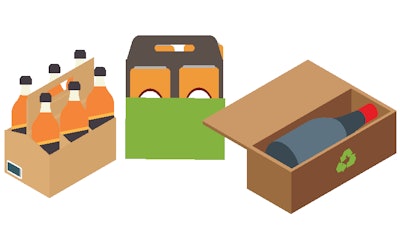
Consumers want their next purchase to match their own sustainability values. Even with the challenges it may bring, this consumer demand opens an opportunity for craft beer and spirits producers to stand out with sustainable strategies, according to PMMI Business Intelligence’s 2024 “Craft Beer and Spirits: Success Through Packaging” report.
Among consumers under 45 years old, 86% are willing to pay more for sustainable packaging, while 57% are less likely to purchase products they perceive as having a harmful sustainability impact, Business Intelligence researchers quote from Sarah Miller’s article, “IWSC Market Insight: Sustainable Spirits Packaging.”
Where to start with sustainability strategies in craft beer and spirits
Craft producers should start with the package itself when analyzing sustainability credentials, as the material, format, size, and weight are all important considerations.
For craft producers, it is often a good idea to combine multiple different package sustainability solutions into one holistic packaging sustainability strategy.
There is no single right answer as to how craft producers should build a sustainable packaging identity for their brand, but there are several common approaches to consider, including labeling, material switches, and lightweighting.
Label sustainability
To improve label sustainability, craft producers should make sure they are using environmentally friendly adhesives for their labels.
Sustainable glues can improve the environmental image of a product. That said, craft producers must ensure the glue is still strong enough to hold up to moisture accumulation during production and shipping, yet still be relatively easy to remove and wash off for recycling.
Label ink should also be carefully evaluated for environmental friendliness. Natural inks free of harsh chemicals can improve sustainable credentials of a label and even make it more likely to be accepted into local recycling streams.
Like glues, craft producers must ensure their sustainable ink solutions are durable enough to handle production and distribution without smudging or running.
OEMs and suppliers can assist craft producers in these initiatives by helping test the viability of new glues and inks on existing machinery. If problems arise, OEMs and suppliers should stand ready to help craft producers adjust their equipment, rethink processes, or even add new equipment to address challenges.
Switching Materials
Switching materials is a common sustainability avenue for craft producers.
Fundamental switches like moving from glass to aluminum packaging can yield significant year-over-year carbon footprint reductions, simply due to the more resource-intensive production requirements for glass packaging. Considering the lower weight of aluminum packaging for transportation, the potential emission reductions from a material switch become even more apparent.
Craft producers can also incorporate more post-consumer recycled content to improve sustainability.
OEMs and suppliers have an especially important role to play when it comes to packaging material switches. New materials can create significant hiccups for existing packaging machinery setups, from different tensile strengths to entirely different shapes and sizes.
OEMs should endeavor to make their machines flexible, with capability to accommodate different materials and adjust for different sizes.
Machines that are versatile and adaptable will be most attractive to craft producers. A plurality of 27% of craft producers surveyed for the Business Intelligence support note flexibility as the single most important feature they look for in packaging machinery.
Lightweighting
 Lightweighting packaging can lower a product's carbon footprint in both production and distribution.PMMI Business Intelligence: 2024 Craft Beer and Spirits - Success Through Packaging
Lightweighting packaging can lower a product's carbon footprint in both production and distribution.PMMI Business Intelligence: 2024 Craft Beer and Spirits - Success Through Packaging
This strategy, commonly referred to as lightweighting, improves sustainability by lowering the overall carbon footprint of producing the package, as well as through emission reductions derived from lower overall unit weight during distribution.
While these weight reductions can translate into significant packaging sustainability boosts, craft producers will need to work closely with OEMs and suppliers to ensure the lower weights and thinner walls of these packages remain durable enough to survive production and handling.
SOURCE: PMMI Business Intelligence: 2024 Craft Beer and Spirits: Success Through Packaging
For more insights from PMMI’s Business Intelligence team, find reports including “2023 Sustainability and Technology: The Future of Packaging and Processing” and “2023 The Impact of Global and Local Standards on OEMs and Suppliers” at pmmi.org/business-intelligence.
Download the FREE report below.



















